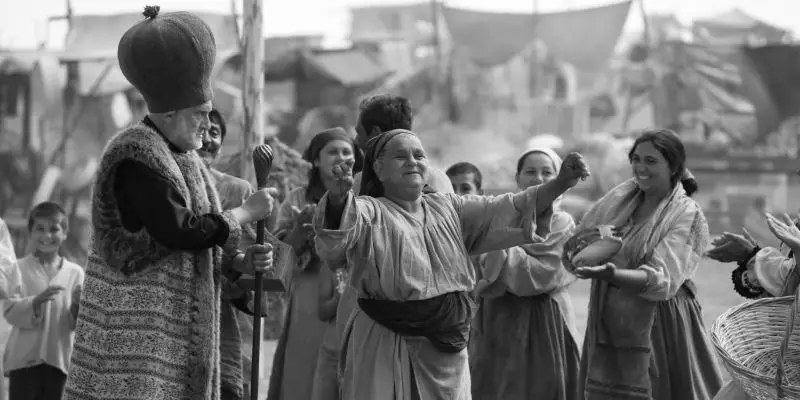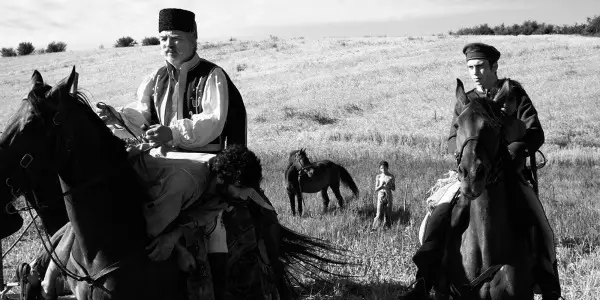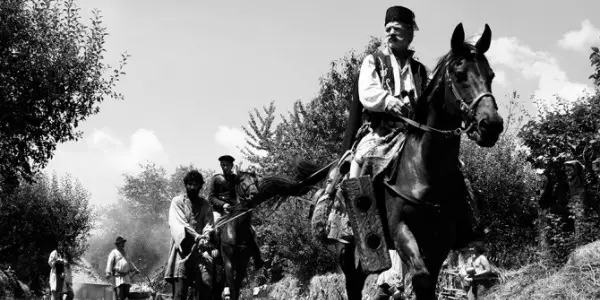AFERIM!: An Excellent Film Which Fails To Hit The Spot

I love film, more than people probably, and I will…
There are two thoughts that go through your head when you hear about a Romanian film which won the Silver Bear for its director Radu June (at the 2015 Berlin Film Festival), and which has been earmarked as the country’s entry into the Foreign Film category at this year’s Oscars. The first is that this must be a very good film indeed.
The other is that this is the sort of film that groups of people gather around and agree is an artistic and important film, but ultimately it’s not very entertaining. As it is Aferim! is a mixture of the two. While I can see that it is a well-made and important film, with entertaining moments, I also found it to be one in which an important point is lost in what is quite a dull atmosphere.
An Important Message
There is no doubting that Aferim is a very well-made film. The narrative is smooth and even, and the point very clear. The film is set in early 19th century Wallachia (present day Romania). Local lawman Costandin (Teodor Corban) and his son Ionita (Mihai Comanoiu) are on a mission to capture the thief and gypsy Carfin. Gypsies are immigrants to the country and, it is revealed, are treated incredibly poorly and used as slaves.
Costandin and Ionita’s mission leads them across the country and through many different landscapes. Along the way they meet a number of people, who all share the common belief that Gypsies cannot be trusted. Costandin and Ionita are more subdued on the subject, while they do not appear to hold the same views they don’t actually speak up for the Gypsies.

While the film spends much time pondering, sometimes comically, on Costandin and Ionita’s relationship and their mission, the film’s real turning point comes when they capture Carfin. They learn that he has been having an affair with the boyar’s (a nobleman) wife and it was because of fear for his life that he ran away. Costandin’s trust in him, and a young boy (also a runaway slave) is what provides the film with its all important conflict.
The enslavement of Gypsies is a very real part of Romania’s history and, as far as I can see, one which is widely forgotten. To bring it to the fore in a film such as this is admirable. Across contemporary Europe there is a still a prejudice against Gypsy culture. A film like this makes us face point blank how we unreasonably treat Gypsies, and immigrants as a whole in the Western world. For this reason I believe Aferim! to be a very bold and important film. Unfortunately while its intentions and making are of a high standard, as a story it never really hits home.
A Well-Made Film?
When I say that Aferim! is well-made I mean it, there’s not a shot, line or edit out of place. It is seamless. The story unfolds slowly but surely, the dialogue is witty, and the performances (especially of Teodor Corban as Costandin) are very good indeed. However, this is what makes it a good film on the surface. Even with its important message one thing Aferim! lacks is depth.
The relationship between boisterous Costandin and son Ionita is sweet, and occasionally funny, but we never really get to understand them or how they feel about one another. What does Costandin want for his son? How is Ionita influenced by his father’s job and beliefs? We never get to know, and one could spend the whole film waiting for more. Likewise the relationship between Costandin and Carfin is an important one, but despite a bit of vague soul-searching by Costandin, and a small bid to protect Carfin, nothing really comes of this.

Aferim! unabashedly, but wisely, takes a lot of inspiration from the John Ford westerns which similarly inspired the Spaghetti westerns and more contemporary Hollywood films. It is very reminisicent of films like True Grit and The Searchers. It is a long journey, with an aim, but with no real rush to get there.
There is no problem with space and silence when a film has a real sense of impending doom or an under current of emotion between those taking the journey, but because Aferim lacks the depth it is striving for the distance between important scenes just feels long and unnecessary. While there is no denying the perfect cinematography and beauty of the landscape, if you are not interested in the story all this can just feel like wallpaper if it is not imbued with meaning. What does this sprawling landscape represent? Loneliness, distance, time? The great Westerns all had some idea in mind, but in Aferim! it is just space to be moved through.
A Technical Sticking Point
My real sticking point with the way Aferim! was made, and one which bothers me hugely, is that although it takes much from classic Westerns it is not in colour, but black and white. And a drained black and white at that. It reminds me of the black and white filter that is so common in digital photography these days, and which gives an image a washed out grayscale colour range. Hence, my surprise in learning that it was shot on Eastman 35mm black and white film.
Shooting on black and white film in this day and age is an unusual and extraordinarily expensive way to shoot a film. However, the results of using such a medium are usually of such a high standard the expense cannot be questioned. The shadows, contrast and drama of the medium is beyond reproach. But while Marius Panduru’s framing is quite stunning, I was disappointed to see how ill-used the black and white medium was in Aferim!.

For a film which takes such great inspiration from the Western (which is ubiquitous with Technicolor) I found it unnecessary. Also, when shooting outdoors the artistry of black and white can be lost. Instead of a high contrast between light and dark you end up with an endless grayscale. Meaning that definition is lost and the filmmaker has ended up wasting money on the film stock itself, or wasting money ushering their production into the brightly lit countryside. Ultimately, I find the use of the black and white medium in modern films hugely unnecessary. This is not to say I don’t appreciate it when it is used well, but on the whole (as in Aferim!) it has clearly been used as an affectation and I believe that is to the detriment of the film as a whole.
Conclusion
Despite my consternation with Radu Jude’s decision to use black and white film I can’t doubt that Aferim, overall, is an excellent piece of filmmaking. As a message about the treatment of Gypsies in the history of Romania, and also as a reflection on their treatment in modern day Europe, I cannot help but be impressed with it. However, as a narrative film I find that it doesn’t present anything particularly engrossing or meaningful.
The film was perhaps meant to be about Costandin and his changing views towards the Gypsies after meeting Carfin. But Costandin doesn’t really express himself. Is he a good man bound by his position? Is he helpless to defend Carfin? Or does he simply not care enough? He begins the film as a semi-reasonable man and ends it as one too, nothing changes and nothing is impressed upon us. Ultimately, we don’t care what happens to Costandin, Ionita or even Carfin. This lack of depth and emotion means that in the end Aferim feels like nothing better than a pleasant trip through the beautiful Romanian countryside.
Will you be seeing Aferim!? Or have you already? What did you think about it?
Aferim! will be released in the US on January 22nd, 2016, there are no current plans for UK distribution. For details of Aferim!’s distribution in your country, see here.
https://www.youtube.com/watch?v=mmTYOY_jQWc
(top image source: Parada Film)
Does content like this matter to you?
Become a Member and support film journalism. Unlock access to all of Film Inquiry`s great articles. Join a community of like-minded readers who are passionate about cinema - get access to our private members Network, give back to independent filmmakers, and more.
I love film, more than people probably, and I will watch pretty much anything. Seriously, anything! I have a postgraduate education in film & have spent an exceptionally long time trying to get inside the film industry. I'm a big believer in treating every film the same, and bringing something new to the film theory table, giving reasons for every argument made. You'll find that I'm an empathetic and fun sort of reviewer, at least, I like to think so. If I'm not watching films I'm doing exceptionally nerdy stuff, like watching documentaries about the history of medicine and collecting photos of old post boxes.













